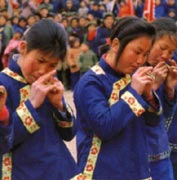"Dong Dongkui" and "Da Liuzi"  "Dong dongkui" is a single reed and elytron-form instrument. It is usually 15 centimeter long, with its diameter 1-2 centimeter or so. It has 3 or 4 holes along the wall, with one end cut as hollow and single-sound hole. Simple as it is, it could produce merry and clear tune, and therefore enjoyed great popularity among women and children of Tujia. "Dong dongkui" is a single reed and elytron-form instrument. It is usually 15 centimeter long, with its diameter 1-2 centimeter or so. It has 3 or 4 holes along the wall, with one end cut as hollow and single-sound hole. Simple as it is, it could produce merry and clear tune, and therefore enjoyed great popularity among women and children of Tujia.
As to the origin of the "Dong dong kui", there is a legend in Tujia folks. In the Qin Dynasty, the emperor recruited men to build the Great Wall. The armies caught a Tujia young man called "Dong Dong". After he was taken away, his pregnant wife named Ba Lie was maltreated by her mother-in-law. Lonely and helplessly, she went up to the mountain to look over the north, where her husband was caught away, hoping to see him back. When she was waiting, she played a bamboo flute, which she made from a small bamboo by herself to express her eagerness of seeing her husband. She played it day after night, waiting and missing her husband, until one day she was found dead on the mountain. Moved by her story, people showed great sympathy to her and began to make flute like hers, calling Dong Dong back for her. (In Chinese, "gui" means "to be back."). Later on, this kind of bamboo flute was called "Dong dong Gui"
"Da Liuzi", also called "Da Jia Huo" and "Da Jia Ye". It is a kind of ancient folk percussion instrument enjoying great popularity in the northwestern part of Hunan Province where Tujia minority habitats. This instrument is made up of Ma gong, Tu gong, big cymbal and second cymbal. It is usually performed by an ensemble of three or four people. Thus, it has the forms of three-player Liuzi and four-player Liuzi. The five-player Liuzi, added with a Suona (a kind of Chinese musical instrument) and combining the forms of piping and drumming, could make the atmosphere more joyous and festival.
There are various songs with abundant contents in Da Liuzi. It has the songs specially for marriage, and common-used songs applied to various occasion such as the Spring Festival and Waving Festival. The drumming of gongs and cymbals varies according to the different songs. When playing, the Ma gong takes the lead, coupled by big and second cymbals, and Tu gong kicks in when time comes. Thus audience can hear over 100 different songs.
Da Liuzi is classic in style, bright and clear in melody, changeable in tune, and is honored as the "symphony of Tujia".
"Catching the New Year" <<
Cry and Marry >>
|